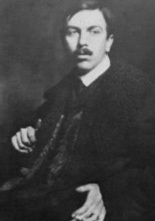
Alson Skinner Clark
b. 1876, Chicago, IL - d. 1949, Pasadena, CA
Alson Skinner Clark was an American Impressionist painter, best known for his landscapes. He was born in Chicago and began taking art classes at the School of the Art Institute of Chicago (SAIC) at age 11. His father worked in commodities trading at the Chicago Board of Trade, and the family lived in Europe for two years, visiting churches and museums and attending the opera. When Clark returned to the United States, he finished high school and enrolled full-time at SAIC. He became impatient with the slow pace of academic training, however, and left Chicago to attend the Art Students League in New York. There, he studied under William Merritt Chase, whom he also worked with at the Chase School of Art and the Shinnecock Summer School of Art. In 1898, Clark set out for Paris, studying with James McNeill Whistler at the Académie Carmen. Though known for his difficult temperament, Whistler was an influential instructor, affecting Clark’s palette and compositional structures.
Clark eventually returned to Chicago around 1900. His large oil painting, Wells Street Bridge and Northwestern Station, completed around this time, shows the influence of his training in French Impressionism, especially in his choice of an industrial, urban subject matter. Using a bright palette, Clark depicted chic urbanites walking beneath the train line as whiffs of smoke dot the line of buildings behind it. The canvas—composed of soft yellows, peaches, and greens in contrast to the dark blacks and browns that delineate the architectural elements of the tracks, the building, and the standing figure on the lower right—captures the beauty and harmony of life in the modern city.
Though not as well known as some of his fellow American Impressionists, Clark had a successful career as a painter and muralist. He began exhibiting at Art Institute of Chicago annual American shows in 1901. He won the Martin B. Cahn Prize for the best work by a Chicago artist at the museum’s annual American exhibition in 1906 for The Coffee House (1905–06; Art Institute of Chicago). He subsequently was awarded solo exhibitions at the AIC in 1906 and 1916, and won bronze medals at the 1904 Louisiana Purchase Exposition in St. Louis and the 1915 Panama-Pacific International Exposition in San Francisco. He also completed a number of significant murals, including The Pied Piper, 1939, for the Mancel Talcott Elementary School in the West Town neighborhood of Chicago (restored in 2001).
During World War I, Clark served in the U.S. Army as an aerial photographer. Afterwards, he continued to travel extensively throughout Europe and the United States. In 1919, he and his wife moved to Pasadena, California, for health reasons, where Clark taught fine art at Occidental College, and served as director of the Stickney Memorial School of Art.
Lisa Meyerowitz
References
Barter, Judith. The Age of American Impressionism: Masterpieces from the Art Institute of Chicago. Chicago: Art Institute of Chicago, 2011.
Becker, Heather. Art for the People: The Rediscovery and Preservation of Progressive- and WPA-Era Murals in the Chicago Public Schools, 1904–1943. San Francisco: Chronicle Books, 2002.
Solon, Deborah Epstein. An American Impressionist: The Art and Life of Alson Skinner Clark. Pasadena, CA: Pasadena Museum of California Art, 2005.
Artist Image: Alson Skinner Clark / photographer unidentified. University Club of Pasadena.
